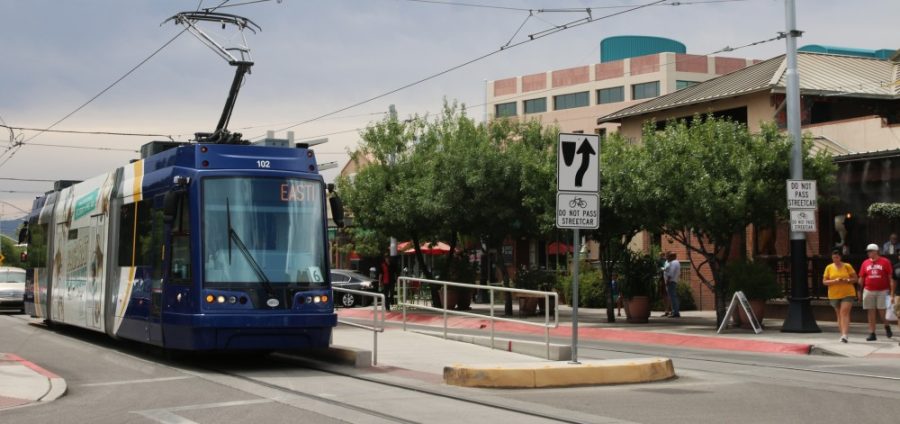Walking is not just a means of transportation, it is a way of life. Walkability is core to a city’s identity, and this holds true for Tucson despite being smaller than some of the more iconic walkable cities like New York City or Tokyo. A large portion of Tucson’s walkability and ease of transportation comes from convenient access to the Sun Link, which may be subject to a change in January when fare-free riding is set to expire.
Walkability is an amorphous concept that can generally be understood to refer to how a space is designed with pedestrians in mind to facilitate foot traffic. In the United States, walkability can be hard to find as most cities are designed more for the car than the person. In much of the greater Tucson area, you’d be hard-pressed to find a single square mile that would be considered walkable.
Walk Score, a popular online tool that rates neighborhoods and assigns a walkability score based on multiple factors, rates Tucson as the 27th most walkable city in the U.S. Walk Score assigns points based on the accessibility of the city to pedestrians. Points were reduced based on the relatively few restaurants and grocery stores within walking distance for the average Tucsonan. Additionally, points were reduced for the limited public transportation options for those on foot. Put simply, in Tucson, like in much of the United States, you need a car to get around. The reliance on personal vehicles to move through Tucson is so apparent that it has even served as a somber inspiration for resident artists like Nazafarin Lotfi.
However, closer to the university there’s an oasis of walkability. In the area surrounding campus, there are bridges underneath Speedway Boulevard, which allow foot traffic to avoid dangerous road crossings, and the aforementioned Sun Link, which allows passengers to go further distances in a free and shaded tram. These features open up access to a much wider area than many pedestrians take advantage of, and I’d like to see that change.
After moving to Tucson, I quickly began taking walks from my home in the direction of campus to familiarize myself with the area. I first noticed what a rarity sidewalks seem to be as I often found myself forced to choose between walking on someone’s lawn or sharing the street with cars and cyclists. When I reached Speedway Boulevard, I was happy to see that some attention to safety had been paid, as there was a means of crossing underneath, saving me a route that has been far too dangerous at times.
Once on campus, the emphasis on walkability was apparent. Numerous paths carve the campus away from speeding cyclists and distracted drivers, lined with trees and benches for shade and beauty. There are several stops for the Sun Link as well as you get closer to the heart of campus, perfect for anyone looking to go from campus out west or vice versa. As a student, being able to walk to class and not worry about paying for parking or a Sun Link ticket is life-changing. I’m more incentivized to explore the area when I can do so freely and easily with the power of my two legs.
In addition to the practicality of walking, there are numerous health benefits. Walking is an aerobic activity that can count towards the Centers for Disease Control and Prevention recommendation of 150 minutes of moderate activity per week. The specific benefits associated with walking are many and include weight loss, increased energy levels and strengthening your immune system. Walking is a convenient exercise for most people to do, given its minimal required gear and low impact on the body. For people on a fitness journey, walking is an easy exercise to track, as most smart devices have built-in pedometers that will track your distance so you can set informed goals.
Walking is not only a great way of maintaining a healthy body but walking has been shown to benefit mental health in a myriad of ways. Studies into a city’s walkability showed that people who lived in more walkable areas had higher socialization, meaning people who lived in an area that was more accessible by foot were more likely to trust others and be socially and politically engaged. Walking improves sleep too, which is correlated with having a better mood. Studies have also shown evidence that even brief 10-minute walks are linked to improvement in depressive symptoms. Walking, like drinking water, is one of those rare phenomena that are easy to do and confer a multitude of health benefits.
While walking generally doesn’t require skill to do, there are still several considerations that should be made before lacing up and going out. The most important consideration when going for a walk is safety. If you are going to walk around campus, it would be wise to sign up for UAlert so that you can get notified immediately if it ever becomes unsafe to be out and about. Additionally, it is always smart to have other people with you and to be aware of the location of the nearest blue light emergency phone, especially at night. If you’re walking at night and feel uncomfortable, don’t forget you have access to a free pick-up service through SafeRide by calling 520-621-SAFE (7233). I want to reinforce that I have walked around campus many times without concern, but it is always prudent to be considerate of your resources when doing so.
RELATED: UA students speak out for free transit at Tucson City Council meeting
As mentioned, a large part of the walking experience on campus involves using the Sun Link to save time and steps. I’ve had several long study days in which I make my way from Scented Leaf Tea House to Time Market, before ending the evening out on Fourth Avenue, all conveniently along the same free streetcar line. As it stands, the Sun Link will halt free fare after the end of this year. I can’t imagine life without it, and I have no memory of life before it, so I’ve reached out to someone who can remember a time with fares but is working to keep that time in the past.
To better understand campus walkability and the challenge it faces, I spoke to Associated Students of the University of Arizona President and lifelong Tusconan Patrick Robles. In an interview conducted via phone call, I asked him about the impact of the decision to make the Sun Link free in March 2020. Robles said, “Free transit has been an economically helpful, safe mode of transit and environmentally friendly.”
Robles emphasized the financial implications for cash-strapped students, going on to say, “It’s no secret that we live in a time of great economic peril, tuition continues to go up and so does the cost of living. We have to do whatever we can do to make people’s lives easier and more livable. That’s less money people have to spend on gas, that’s more money going to students and what they need.”
Robles acknowledged that there are financial implications for the Sun Link as well since they would be losing fares, thus setting the scene for the current fight that he and many other students find themselves in. Dozens of students, Robles included, attended a town hall meeting on Aug. 24 to voice their concerns. Ever since, Robles has been active with other students, continuing to advocate for free fare for students by attending council meetings and meetings with prominent figures including the Mayor of Tucson and UA President Dr. Robert C. Robbins.
When asked about the current status of their work, Robles mentioned that in recent meetings, “Student leaders were name-dropped by council members and the mayor as a result of conversations between UA students and parking and transportation services.”
Although campus walkability will likely not be completely decimated by a decision to reinstate fares, the Sun Link remains crucial to students’ ability to walk and explore their community. Free public transportation enables convenient and more diverse walks, which makes for happier and healthier students. As such, the fate of the Sun Link affects us all.
In closing, I’d like to leave you with Robles’ advice to students who want to get involved, “Come visit us at the UA office on the 3rd floor of the Student Union, we’re actively working on a myriad of issues … I recommend folks email pts-parkingmarketing@arizona.edu to reach out to UA’s Parking and Transportation services department. The more students they hear from, the more pressure placed.”
Follow the Daily Wildcat on Twitter

Ben Pope is a second-year medical student at the UA. Although native to Tempe, he has moved down south to study medicine and enjoy all the good food Tucson has to offer.









